You post on your blog once a month. The content is purposeless, without direction, and isn’t directly aimed at anyone in particular. “That should be good enough, these posts will drive some more traffic to my website”, you say to yourself. Customers then get stuck at the top of your marketing funnel, never to come out on the other side.
Does this sound like you? Is your content strategy in need of a serious update?
We get it. People want to run for the hills when they hear the words “content strategy”. It’s a tough concept to get the hang of. All the different types of content available can make it difficult to choose which ones you want to zero in on. On top of that, you need to tailor your content based on who you’re targeting. Is it your top of the funnel audience? Middle of the funnel?
Unfortunately, you can’t just wish these problems away. Content marketing is an integral part of any inbound marketing strategy and having a solid content strategy will set you on the path for success.
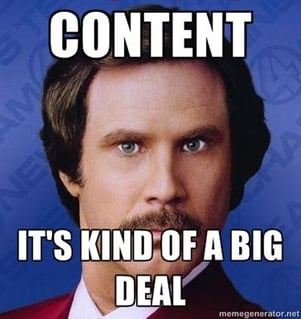
Just look at the stats. For every dollar spent, content marketing will net you three times as many leads as traditional outbound marketing, all while costing you 62% less overall. If that isn’t enough to convince you to put your head down and develop your content strategy, we’re not sure what will.
| Content Marketing | Traditional Outbound Marketing |
|---|---|
| Draws in interested customers | Seeks out customers, regardless of interest |
| Designed around the needs and problems of the customer | Disruptive and typically designed with the company’s interests in mind |
What is a Content Strategy?
In order to fully reap the benefits of planning out a foolproof content strategy, you’ll first need to understand exactly what a content strategy is. Nobody can run before they learn to walk.
You’ve likely heard both the terms “content strategy” and “content marketing” used interchangeably. That’s okay! While the terms do have different meanings, they do fall under the same umbrella. Without a content strategy, content marketing efforts fall flat.
Content Strategy Definition
To put it as simply as possible, a content strategy is the thought, research, and planning that goes into managing a successful content marketing campaign. This includes, but is not limited to:
- Defining your specific goals
- Figuring out your target audience
- Deciding which types of content to use
- Researching content marketing tools
- Analyzing your efforts
There are certainly a lot of aspects that go into a successful content strategy. However, learning the proper steps to take will go a long way towards ensuring success with your content marketing efforts.
Why is an Effective Content Strategy So Important?
Just as an astronaut would never hop in a rocket and fly into space without intense mission planning preceding it, launching into content creation without an effective content strategy would be business suicide.
Think about it this way. If you don’t have an accurate picture of who your target audience is, how do you know what content you should start with? Rewinding from there, if you don’t even have a specific goal, how do you measure if your content efforts are paying off?
The importance of an effective content strategy essentially boils down to the fact that almost no effort in business will pay off without proper planning first. You can rest assured that you’ll end up being caught with your pants down if you dive into content creation headfirst with zero direction.
Developing Your Content Strategy
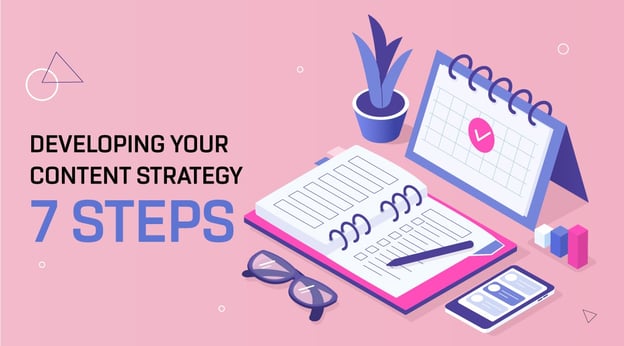
So now you know exactly what a content strategy is and what the benefits are of having one in place.
What now? How do you put these visions into practice? What are the steps?
Well, here are 7 steps you need to take in order to properly develop an effective content strategy:
- Define your goals
- Figure out your target audience
- Decide what types of content to use
- Gather the proper tools
- Create a content calendar
- Distribute and market your content
- Analyze your efforts
Define Your Goals
Stop right now and ask yourself: why am I creating content? What is the purpose of the content I’m creating? What am I trying to achieve with my content?
Before you move any further, you need to hone in on what you’re going to use your content for.
And it gets more complicated than that. Simply saying “I want to boost my conversion rates” or “I want more website traffic” isn’t enough. These are great starting points, but what are you actually measuring here? How much of a boost are you looking for? What do you mean by “more”?
This is where a common business practice known as setting “SMART” goals comes into play.
So what are SMART goals exactly?
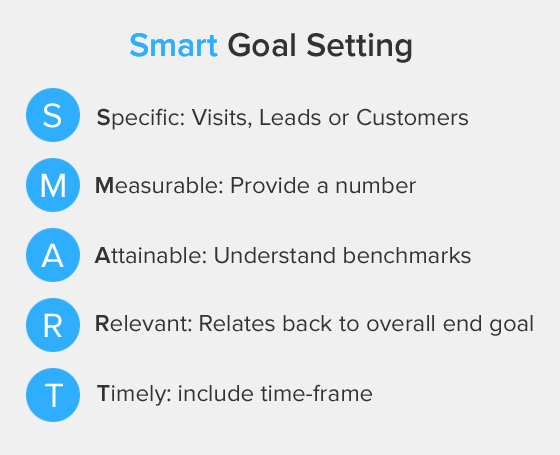
- Specific
- Measurable
- Attainable
- Relevant
- Time-based
Neat, huh? Using this framework for setting goals will make sure that your defined goals make sense. Not only can you properly measure them, but they’ll also help you further your business.
Let’s say you’re in the SaaS business, for example. Instead of saying something like “I want more website traffic”, you can say something like “I want to increase our average monthly website traffic by 15% by the end of the year”. This type of goal fits the SMART framework perfectly. Here we have a specific and measurable amount, attainable, relevant to the SaaS business, and completely time-based.
That’s just one example of the SMART goal framework in action. Make sure all your goals fit into SMART planning and you’ll be off to a great start.
If you want to take it to the next level, HubSpot actually offers a free SMART goal template on their website in order to help you plan, execute, and track your SMART goals effectively.
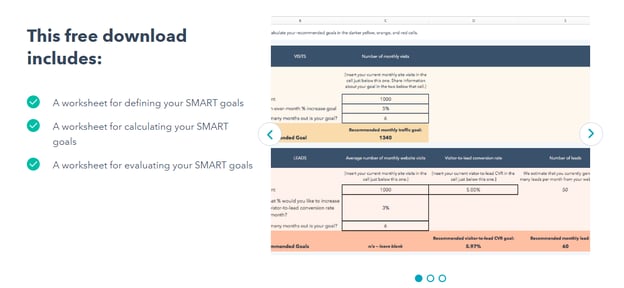
Define Your Target Audience
Now that you have proper, measurable goals in place for your content strategy, you need to figure out who you’re targeting with your content. This is also known as your buyer persona. The ideal picture of your typical customer.
There are two main ways to identify your buyer persona:
- Using demographic data
- Using customer surveys
Demographic Data
Demographics fall into several different categories. These include:
- Age
- Gender
- Income
- Education
You can use Google Analytics to easily figure out which demographic the visitors to your website fall into.
From their demo page, here’s a look at the gender stats of their page viewers:
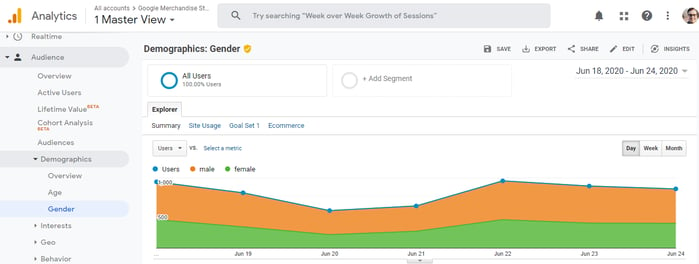
This shows that the viewer base on Google Analytics is split fairly evenly between male and female.
A CRM can also be used to find your customer demographics. Not only that, if your CRM data is kept up to date, you can deduce the average deal size, the role your customer is in at his or her company, and other pertinent info as well.
Thankfully, if you’re trying to pull data from social media sites like Facebook or Twitter, they each have their own analytics tools you can use as well. There, you’ll find similar demographic analysis on their respective dashboards.
Using these demographics, it becomes much easier to paint a vivid picture of your ideal target customer.
Customer Surveys
Demographics alone sometimes aren’t enough to flesh out your buyer persona.
Through customer surveys and feedback, you can figure out:
- What problems your customers have
- The channels and content types they enjoy
- What their priorities are
But how do you actually collect this feedback without being invasive or disruptive? Sure, you could just use a popup or slide-in with a few questions and call it a day. Maybe your customer will fill out the survey. Or maybe they’ll ignore it and bounce from your website, never to be heard from again.
Instead, why not offer an incentive? Discounts can go a long way to persuading your audience to fill out your surveys. A small price to pay for such valuable feedback.
For more information, check out our step-by-step guide to creating customer personas. The last thing you want to be doing is producing content that is completely irrelevant to your audience.
Decide What Types of Content to Focus On
Your goals are set in stone, and now you have a clear picture of your ideal customer and the problems they face.
Now it’s on you to give the people what they want!
However, with the multitude of content types at your disposal, how do you know which ones are your golden ticket?
Well, this is going to depend heavily on who you’re targeting, and where they sit in your marketing funnel.

| Top of the Funnel | Middle of the Funnel | Bottom of the Funnel |
|---|---|---|
| Widest net of leads | Lead count decreases as non serious buyers drop off | Lowest number of leads but much higher quality and ready to buy |
| Educational content without a sales pitch | Balance between educational content and mentions of your product or service | Content based solely around your product and brand |
Top of Funnel

Towards the top of your funnel, the idea is to provide educational value and a solution to a problem your audience is facing. ToFu content is typically more general, as the top of the funnel is wide and has your largest number of leads. Be careful here. Don’t be overly salesy.
Content Example: Blog posts outlining solutions to common problems you know your audience encounters when self identifying a problem your product or service solves.
Middle of Funnel
 Your middle of the funnel content is a little more complex. Aim to provide educational content here as well, but now your product or service can be thrown into the mix. The goal here is to give your audience the information they need to qualify the fit of your product or service for themselves.
Your middle of the funnel content is a little more complex. Aim to provide educational content here as well, but now your product or service can be thrown into the mix. The goal here is to give your audience the information they need to qualify the fit of your product or service for themselves.
Content Example: Webinars are a great way to provide educational value to your customers while still being able to advertise your product or service to an extent.
Bottom of Funnel
 The bottom of the funnel is where you can start pitching sales effectively, flexing your brand power and differentiating yourself from your competitors. At this point your audience has identified you are a possible solution, and it's time to show them why you're the best option.
The bottom of the funnel is where you can start pitching sales effectively, flexing your brand power and differentiating yourself from your competitors. At this point your audience has identified you are a possible solution, and it's time to show them why you're the best option.
Content Example: Product demos work great here. Pitching sales in the form of demonstrating exactly how your product works. Case studies are also power pieces of BOFU content.
Here are a few examples of content you can create:
- Blog posts
- Infographics
- E-books
- Videos
- Social media posts
- Webinars
- Guides/Demos
Mix it up and try a variety of content flavours and measure the effectiveness that each one has with your audience.
Gather the Proper Tools
What’s a carpenter without a hammer? A doctor without a stethoscope?
The same goes for marketers. Creating an effective content strategy means seeking out the tools you need for the task. There are tons of different tools out there to make your job of creating an effective content strategy a lot easier.
Here are three tools that we love that will help get you started on your journey:
- BuzzSumo
- Keyword Exploration from Moz
- Hootsuite
However, there are dozens (or even hundreds) of incredible tools out there to help you get the job done with your content strategies, so don’t feel like you need to use these ones.
BuzzSumo
Having trouble coming up with content ideas? BuzzSumo to the rescue!
Using BuzzSumo, you can:
- Keep track of trending content
- See which platforms this content is being shared on most
- Perform competitor analysis and find out what content is working for your competitors
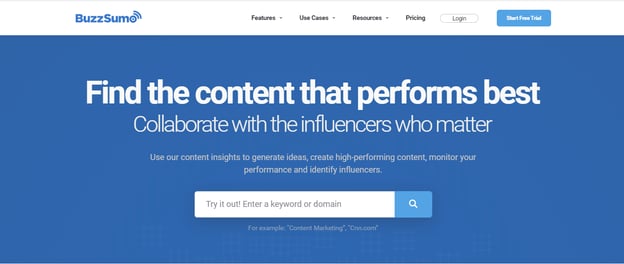
Simply type a keyword into the search bar and BuzzSumo will show you all kinds of content on the web related to your topic, how it’s performing, what channels it’s being shared on the most, and more. You can use this info to help conjure up your own ideas for your next blog post, YouTube video, webinar, or any type of content you’re thinking of creating!
Loads of companies are using BuzzSumo already, and for good reason. Don’t sleep on it!
Keyword Exploration Tool from Moz
Wanna get those blog posts ranking on Google? Then you’re gonna need a tool to research the best keywords to use. Look no further than the Keyword Exploration Tool from Moz!
Simply type in a keyword you’re thinking of using, and the Keyword Exploration Tool will perform a quick analysis of the keyword.
Here’s an analysis of the keyword “landing page examples”:
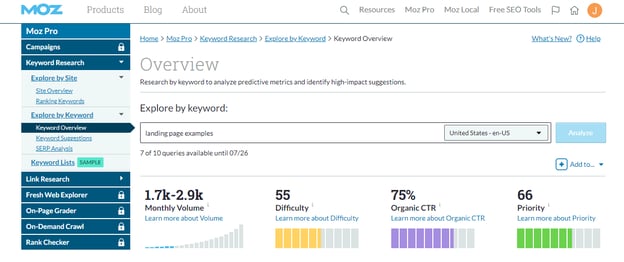
From this easy to use dashboard, you can see the monthly volume of searches, the difficulty to rank using this keyword, the organic click-through rate, and even a priority rating. The priority rating is a number given to a keyword based on a balance between difficulty to rank and organic CTR and monthly volume. The higher the priority rating, the more they recommend using this keyword.
Getting your blog posts onto the first page of Google is one of the pinnacles of any successful content strategy. Use the Keyword Exploration Tool to find those perfect keywords to use.
Hootsuite
Imagine being able to manage all of your social media channels in one place. How about being able to automatically schedule posts based on a calendar of your own creation?
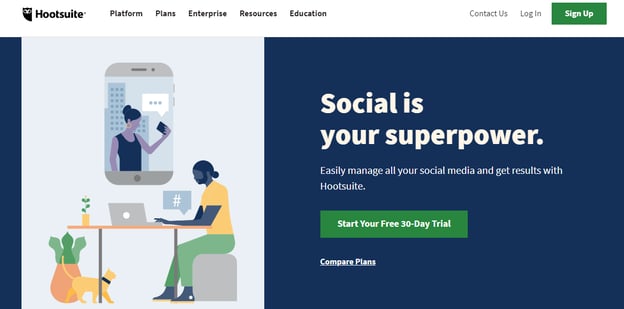
Besides these two groundbreaking features, Hootsuite also provides you with:
- Social media team features
- Access to all your social inboxes in one place
- An academy to brush up on your social media marketing skills
To summarize, Hootsuite is a fantastic addition to your toolbox to streamline your social media content.
Create a Content Calendar
Knowing exactly when to publish certain content is an integral part of an effective content strategy. You don’t want to top load your month and give up all your content right away. It’s important to spread it out evenly throughout the month across all the different channels you’re using to distribute content.
Now, you could just use a physical calendar hanging in your office and call it a day. Or, you could get with the times and use a digital content calendar. Something like Asana works great in planning your content creation and setting due dates.
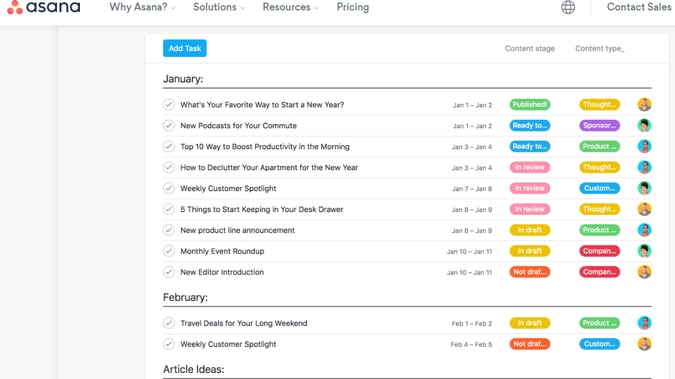
From here, we have an overview of the content schedule for January, where each piece sits in the creation process, and the type of content being produced. Easy to use, easy to understand.
Again, there are many tools out there that will get the job done - it’s all about finding the one that works the best for you. Here at Roketto we use AirTable for managing all of our content calendars, topics, and even our team members.
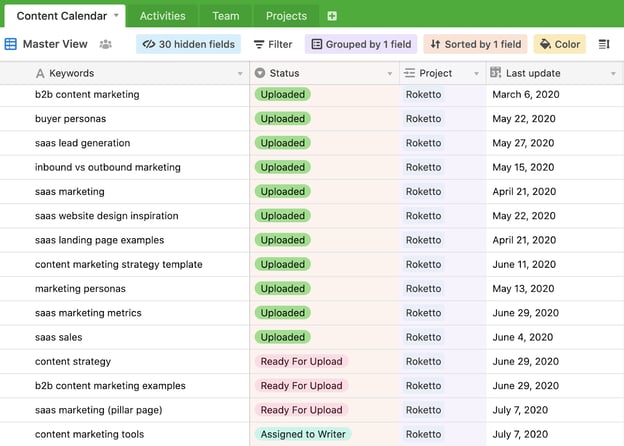
Using a calendar like this will allow your content creation team to easily keep up to speed on what’s coming down the pipe for the rest of the month, or even the next couple of months if you’re the type that likes to plan further ahead.
Keep your content strategy organized and get that calendar planned.
Distribute and Market Your Content
So now you’re well organized, you know what content is being released on what day, and you’re ready to show the world what you’ve created. Excellent work!
However, now it’s time to make sure people are actually seeing this content for themselves.
You can’t just expect to put a blog post up on your website and expect people to come in droves, hanging on every word. Part of distributing your content comes back to knowing your audience and your ideal customer. You should have figured out where they spend their time. Are they more active on Twitter? Facebook? LinkedIn? This is vital information to have when you’re looking to promote your next bit of content.
There’s also another aspect we haven’t talked about yet: Paid ads. These can go a long way to getting your content into the right hands and put you one step ahead of the competition.
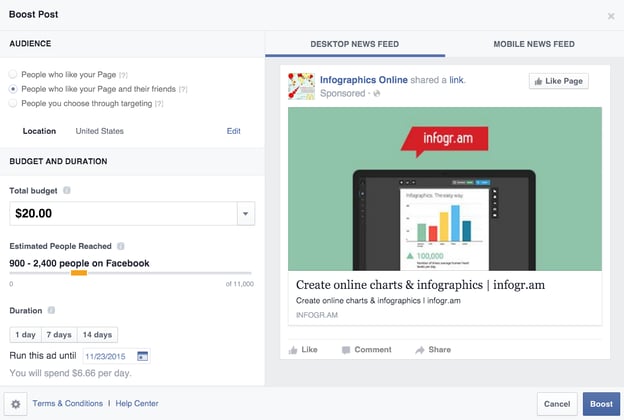
But be careful, diving straight into paid ads before you have an organic audience can be a trap you don’t want to fall into, and can deplete your budget before you can make any progress. Try to dedicate a modest budget to boosting each post. In most cases, $5-$10 can lead to a ton of exposure for your post if done right.
Analyze Your Efforts
Even after all you’ve learned here about developing a rock-solid content strategy, mistakes can still happen. It’s possible that you’re focusing on the wrong content channels. Or maybe your content is aimed at the wrong part of your marketing funnel.
Whatever the case may be, the only way you can truly learn from your mistakes is by analyzing your content efforts.
Ideally, one of the main outcomes you want from your content is a high number of engagements. Is your content being shared? Liked on Facebook? Are page visits up on your blog posts?
These are all indicators of well-designed content.
Checking up on your content is quite simple. Using the aforementioned analytics tools (Google, Facebook, Twitter, etc.), you can see all your engagement stats from simple dashboards.
From there is where the real fun begins. If your content isn’t performing well, then it’s time to look into what you can change to remedy this. Maybe your content is properly distributed and it’s time to change up the channels you’re using. Or maybe the type of content you’re producing isn’t resonating with your target audience.
Failure to adapt will surely spell the end of your content creating efforts!
Examples of Great Content Strategies in Action
Instead of just talking about how to create a content strategy, why not dive into some companies who put the work in and have created innovative content using the above methods?
Uppercut Deluxe
Being a hair product company, Uppercut Deluxe figured out that the majority of their audience wants to see their hair products in action.
So not only did Uppercut show them the results they can achieve, they made videos on how to properly create certain hairstyles using their products.

Video is the future here. And Uppercut has jumped all over it.
REI Co-Op
If you wanna see an example of how to make a blog work for you, look no further than camping and outdoor gear outlet REI Co-Op.
REI knows exactly who they’re targeting. Their audience is all about the outdoors. With posts ranging from the best backpacking tents on the market to a how-to post on making your backyard feel more like the wilderness, REI knows their buyer persona like the back of their hand.

They’ve even segmented their blog into news, gear, and how-to posts making it easy to navigate and find what you’re looking for.
REI Co-Op has dominated their industry with a smart blogging strategy, as we see happen often with those who are willing to put in the time and effort.
Content Strategy Summary
As with most aspects of life, a rock-solid plan comes before any great success. Content marketing is no different. Drumming up a great content strategy is vital to ensuring the highest possible return on investment.
We’ve talked about the seven essential steps to creating a foolproof content strategy:
- Define your goals
- Define your target audience
- Decide what types of content to focus on
- Gather the proper tools
- Create a content calendar
- Distribute and market your content
- Analyze your efforts
And we’ve even shown what a great content strategy can do when combined with a little bit of outside-the-box thinking.
Time to hit the books and get that content strategy mapped out.
Hit a Snag?
Even the best of us get stumped sometimes. Why not drop us a line and we’ll help get you untangled.

Chris Onyett
Chris is one of the managing partners at Roketto. His area of expertise is digital marketing and loves sharing and educating on topics like Google Ads, CPC bidding tactics, Google Analytics, and marketing automation. When Chris isn't in the office, he enjoys playing volleyball, mountain biking, and hiking with his American Eskimo.
















2.png)
2.png)




